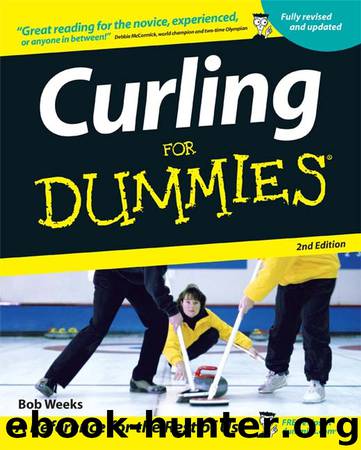Curling For Dummies by Bob Weeks

Author:Bob Weeks
Language: eng
Format: epub
Publisher: Wiley
Published: 2010-05-27T04:00:00+00:00
Choosing your rocks
Most of the time, if your team loses the coin toss, you get to select the set of rocks you will play with. But instead of simply reaching for whichever set is closest, make an educated selection.
Pull out your record book on each set of stones at your club (I talk about the value of keeping a book like this in Chapter 5), and refer to your notes on the two sets of stones on your sheet. See if either set has any bad rocks. If some rotten ones exist — perhaps one or two that are much slower than the others — then select the better of the two sets. Even if you don’t get last rock in the first end, this might be a way to get a bit of an advantage.
Sometimes, the set of stones you use is predetermined, so you don’t get to pick. Some clubs use a system based on the game schedule and the rock colors on the scoreboard. Let’s say that, on the schedule, your rink’s name appears before your opposition’s — your name is above theirs. You would play with whichever color rock appears on the top part of the scoreboard. Sometimes you have to take what you get and make the best of it.
If you’re unsure about what color to throw, ask your skip.
Setting up courtesy stones
Curling is a game of tradition and respect. That’s evident when you shake hands, when you introduce yourself, and even when you step up to throw. Although it’s far from universal, many curling clubs have a practice called courtesy stones. It’s also sometimes called setting up the stones.
A courtesy stone is one that is set up for you by your opponent. You return the favor for the other team.
When you go to throw the first stone of the game, all the stones are lined up at the end of the sheet, out of the way. You go over to the group and pull out the stone you are going to throw. But before you step into the hack, you go over to your opposition’s stones and pull one out for them. You place this stone beside the hack that you’re not using (about 2 or 3 feet away from it, to make sure it won’t get in the way of your delivery). In the same way, when you go to throw, your opponent will set up a rock for you.
The practice of courtesy stones has disappeared at a lot of clubs. That’s too bad for those who believe in the traditions of the sport, but understandable in this age of rock selection. Up until about 15 years ago, the stones weren’t numbered. You often had no idea which two stones you were throwing — you just grabbed one and then the other and tossed them down the sheet.
Even though stones are numbered today, players don’t always throw the numbers they are supposed to. This is because, in recent years, teams
Download
This site does not store any files on its server. We only index and link to content provided by other sites. Please contact the content providers to delete copyright contents if any and email us, we'll remove relevant links or contents immediately.
A Wilder Time by William E. Glassley(2780)
Erebus by Michael Palin(1745)
Arctic Dreams by Barry Lopez(1682)
Winter Calling by Lynn Galli(1584)
The Art of Fear by Kristen Ulmer(1488)
South with the Sun by Lynne Cox(1478)
Mawson's Will by Lennard Bickel(1375)
Caroline Alexander by The Endurance: Shackleton's Legendary Antarctic Expedition(1311)
Big Dead Place: Inside the Strange and Menacing World of Antarctica (Large Print 16pt) by Nicholas Johnson(1307)
Total Hockey Training by Sean Skahan(1293)
South by Ernest Henry Shackleton(1268)
Bugaboo Dreams by Topher Donahue(1266)
Training Season (E) (MM) by Leta Blake(1260)
Zoo Tails by Oliver Graham Jones(1242)
Panama by Lonely planet(1212)
Ice by Unknown(1166)
Ice! by Tristan Jones(1166)
Lonely Planet Panama by Lonely Planet(1119)
Frozen in Time by John Geiger & John Geiger(1108)
